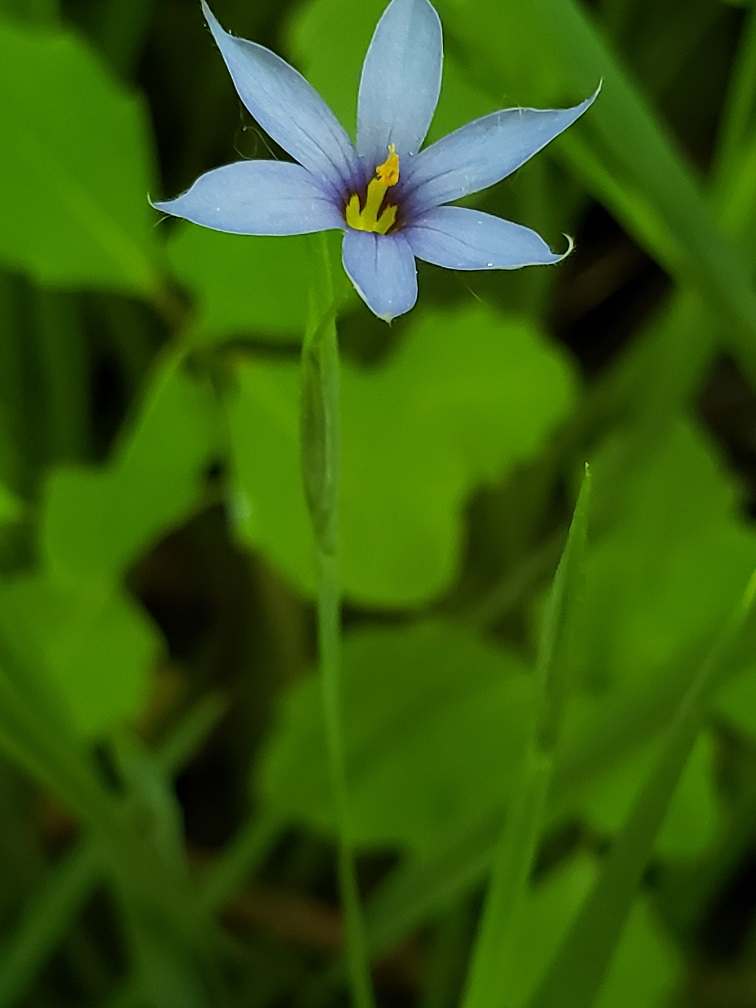This week, I’m featuring Wood Anemone (Anemone quinquefolia) as one of our local wildflowers that begins to bloom at this time.

The compound leaves of Wood Anemone are split into five sections, hence the species name “quinquefolia” or “five-leaved.”
Wood Anemone is one of our true spring ephemeral woodland wildflowers: it completes its entire life cycle–from emerging from dormancy to setting seed–in the spring before the forest canopy closes above it. The above-ground portion of this perennial dies back by mid-summer, leaving only the underground rhizome to await the next spring.
Such a fleeting existence for such a delicate woodland wildflower perhaps inspired William Cullen Bryant’s poetic tribute:
Within the woods,
Whose young and half transparent leaves scarce cast
A shade, gray circles of anemones
Danced on their stalks.
Identification Tips:
Wood Anemone is a perennial herbaceous plant approximately 3-8 inches tall. Leaves are compound in groups of 3, though the lateral leaflets may be cleft so it appears to be 4 or 5 leaflets. A single whorl of 3 stalked leaves sits at the top of the stem with the flower stalk arising from the center. Leaflets are up to 1½ inches long, notched, lobed or deeply divided in 2 or 3 parts, coarsely toothed at the tip end, wedge-shaped at the base, and very short-stalked or stalkless. Leaf color ranges from bright green to (sometimes when first unfurling its leaves) purplish green to dark purple. A single basal leaf similar to the stem leaves, but nearly round in outline, may also be present. Leaves and stems are covered in fine hairs.
A single 1-inch white flower on a hairy stalk arises from a whorl of leaves at the end of the stem. Flowers have 4 to 9 petal-like sepals, usually 5. Faint lines on the sepals may serve as guides to help insects find nectar. The flowers remain closed in low light and have a strong daily rhythm. They open in the morning from a pinkish, slightly downturned bud into a glistening white, upturned cup as the sunlight reaches them. They close again at evening as the light fades. A single plant may take 5 years or longer to flower, so often only a few flowers are seen among the leaves.
Mature flowers produce a dry elliptical to ovoid shaped fruit (achene) containing a single seed that is up to 1/5 inch long with a beak that is straight or curved.
Wood Anemones often carpet large areas due to their growth habitat of spreading via horizontal rhizomes.
Folklore:
The name “Anemone” refers to the gods of the four winds, Anemoi, and means “windflower,” referring to the timing of the flowers opening in the spring wind. According to Greek mythology, Zephyros, the god of the west wind, was infatuated with a nymph named Anemona. Zephyros’s wife Flora was angered by this so she turned Anemona into a flower. Zephyros then lost interest in Anemona, but another wind god, Boreas (god of the north wind), fell in love with her in her flower form. He tried to woo her, but Anemona wasn’t interested, so every spring he angrily blows open her petals, fading them prematurely.
Culinary and Medicinal Uses:
This plant is very toxic. All parts of this plant contain protoanemonin, an irritating acrid oil that is an enzymatic breakdown product of the glycoside ranunculin. While protoanemonin can cause severe topical and gastrointestinal irritation (such as blistering), it is unstable and changes into harmless anemonin when plants are dried or heated.
Despite the plant’s toxicity, it has been employed for a few external medicinal uses. It was used as a rubefacient for treating fevers, gout, and rheumatism and it also has been used as a vesicant for removing corns from feet. The root contains anemonin, which helps to relieve pain (analgesic).
Wildlife Value:
These flowers attract long-tongued bees (such as the Black-and-Yellow Nomad, Nomada luteoloides), short-tongued bees (such as the Eastern Masked Bee, Hylaeus affinis), mining bees, Lasioglossum sweat bees, and hoverflies.
Where Found Locally:




















































